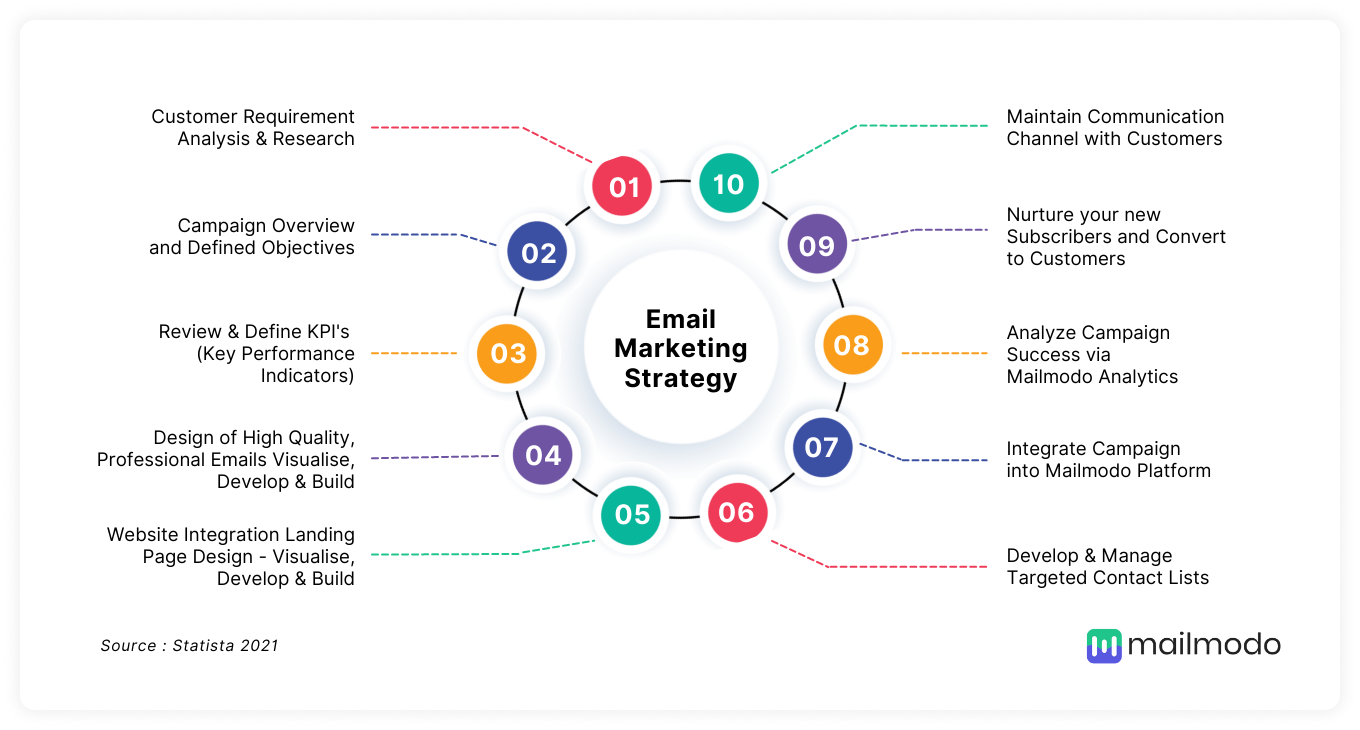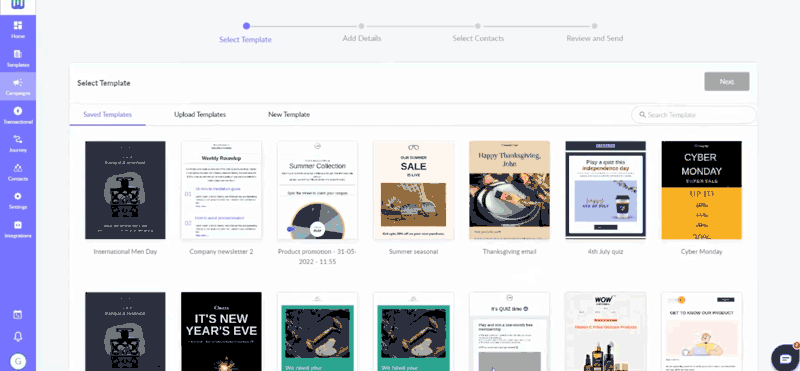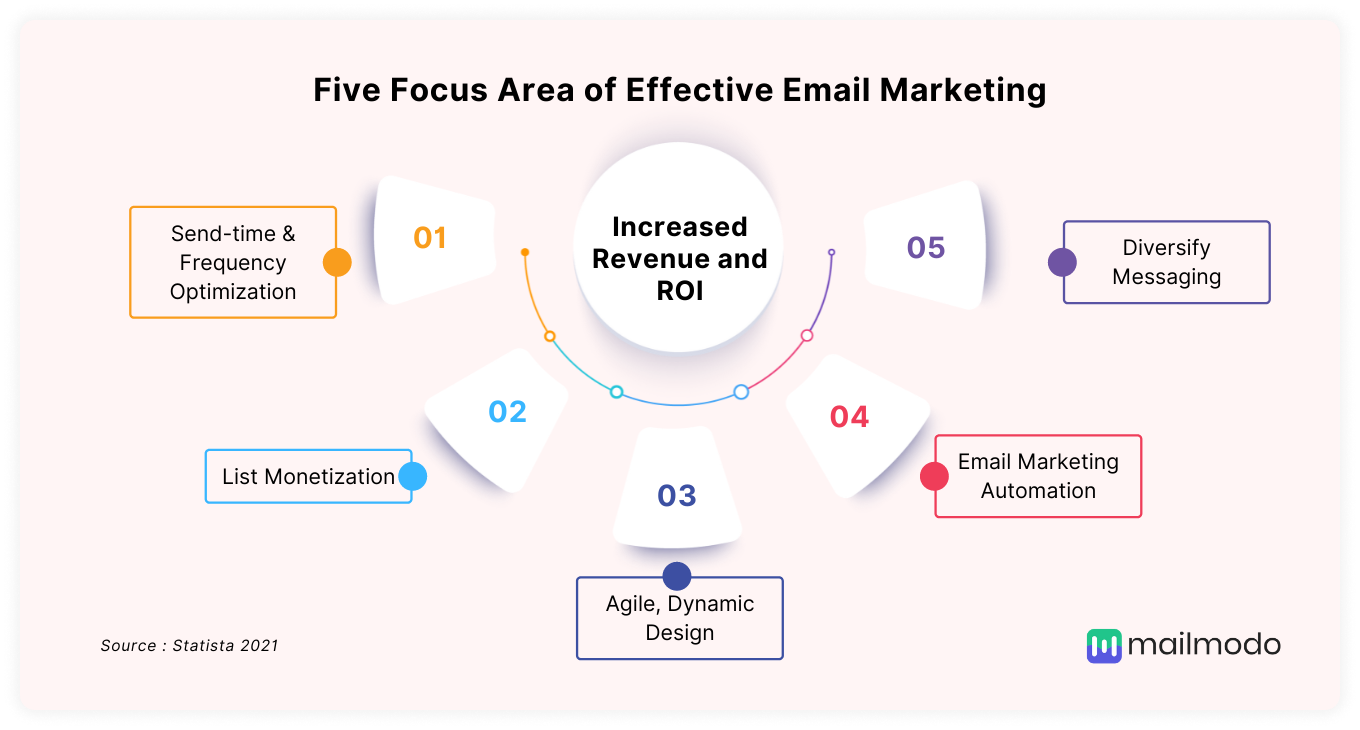Email marketing is one of the best marketing channels businesses use to generate maximum returns for their investment.
We recently surveyed marketers and directors of big brands and marketing agencies. And it should come as no surprise that 63 respondents indicated that email was their preferred marketing medium.
Want to utilize email marketing to the fullest to generate revenue for your business? Read till the end of this guide, where we share some of the best email marketing strategies and expert tips.
🎬 Let's get started.
Table of contents
12 strategies to create a winning email campaign
- 1. Know your campaign goals
- 2. Keep your email list tight and clean
- 3. Warm up your email domain
- 4. Segment your email list
- 5. Authenticate your email domain
- 6. Provide value one email at a time
- 7. Nail your subject lines
- 8. Provide a clear call to action
- 9. Avoid using a no-reply address
- 10. Test, test, and test
- 11. Personalize your emails
- 12. Automate to send timely messages
What is an email marketing strategy?
Email marketing strategy is a data-driven set of actionable plans that email marketers can follow to generate the expected results from the campaign.
Benefits of creating an email marketing strategy
A strategy includes the methods, objectives, and analysis to help you move in the right direction.
It helps take the guesswork out of the campaign planning and set clear goals and steps to achieve the goal.
And you will know what metrics to track and which can help grow your revenue. Also, a perfect email strategy will help you decide what emails to send and when.
This way, everything is mapped out, and you can take care of improving the campaign further.
How to create an effective email marketing strategy?
A smart and fruitful email marketing strategy focuses on:
Defining the goals and objectives of your campaigns.
Target audiences for your email marketing campaigns.
SWOT analysis of your past email campaigns.
Identifying the type of emails and the email cadence.
Leveraging automation for better behavioral targeting and customer segmentation.
The below image outlines the steps of forming a strategy.

12 strategies to create a winning email campaign
Here are the 12 key strategies with expert advice from fellow marketers to create an email campaign that gets you revenue.
1. Know your campaign goals
Like any other strategizing process, you have to begin with the preliminaries or the "stage zero" or "discovery phase."
This stage can also be divided into two steps:
What and Why: Aims and Objectives
During this stage, you thoroughly explore your campaign's ultimate goal because targeted emails convert better, build credibility, and boost your sales.
Some of the common email marketing objectives include:
Sharing information about a newly launched product.
Getting your customers to sign-up for your services.
Getting your customers to buy your product or renew their subscriptions.
Informing your customers about a new feature or service.
Who: How to implement STP (Segment, Target, and Position)
The next part is to identify and establish the ground rules for measuring the progress and success of your email marketing campaign. To ensure that your CTAs get clicks and good responses, you must:
Segment your customers and target audiences based on various parameters, such as behavior, preferences, purchase capacities, and previous data.
Target your campaigns for each customer segment, and offer them personalized offers, information, and deliverables.
Position your campaigns to stay aligned with your email marketing goals.
You can set specific metrics to measure the progress and success of your email campaigns.
Once you are done, you are ready to enter the key stages of developing an email marketing strategy.
2. Keep your email list tight and clean
Email marketing is all about sending the right messages to the right people. And list clean-up is one of the common email marketing pitfalls to avoid.
You must continuously clean up your email list by removing unengaged and unsubscribed members.
Create an effective sunset policy to reduce spam complaints and email deliverability issues.
"Getting a sunset policy doesn't seem like an urgent requirement for your email marketing campaign, but in the long run, it's one of the most vital ones. You don't want to spam people. If someone is not interested in your services after all your efforts to woo them with the best offers, maybe it's time to let them go. Your list hygiene is what will make or break your email marketing strategy. And for that, sunsetting subscribers at the right time is essential."
- Apurv Gupta, Co-Founder of Mailmodo
3. Warm up your email domain
You are just starting with your email marketing strategy. So if you think you can send thousands of emails with your new email domain without any issues, then you are wrong.
You might ruin your reputation and end up in spam folders if you are not warming up your domain. Email domain warmup helps you establish a sender reputation and ensures the possibility of landing in the inboxes.
"Warm up your domain by sending your email campaign to a small portion of your subscribers. Then, gradually increase the audience size and frequency of the warmup emails."
- Pratik, Customer Success at Mailmodo
4. Segment your email list
Sending the email campaign to everyone on your list will hurt your email strategy. Not everyone will like your email and might unsubscribe or mark your email as spam. It will hurt your reputation and business revenue as a whole.
Email segmentation helps you send highly targeted and relevant messages to each contact segment to provide a personalized experience to your audience.
Segment your email list by:
Demographics
Previous campaign data
Preferences and interests
5. Authenticate your email domain
Email authentication helps improve your email deliverability, i.e., it reduces the possibility of your email landing in the spam folder. It helps spam filters understand that emails come from a legitimate source.
Ensure you follow all the email authentication protocols like DMARC, DKIM, and SPF. If you are using AMP emails, get your sender address whitelisted by the email clients.
💡 Related guide: Understanding email authentication protocols
6. Provide value one email at a time
This is THE most important email marketing strategy to create a better campaign. Creating valuable content is hard yet possible.
After segmenting your contact list based on their preferences, you might now know their wants, needs, and characteristics. Just make sure to share content that resonates and solves their problem.
Never shy away from asking for feedback from your audience. Send out an email survey to find out what works and does not.
"Provide value with every email. We include sample marketing insights from our newsletter even in our subscription confirmation message. It'll increase brand affinity, open rates, conversion rates, and decrease unsubscribe rates."
- Neal O'Grady, Co-Founder, Demand Curve
7. Nail your subject lines
Email subject lines help improve your email open rate. Without improving your open rate, it is hard to see any ROI for your efforts. Personalized email subject lines make people want to open your emails.
Here are some tips to improve your subject lines:
Keep your subject lines to less than 90 characters.
Use CTA-based subject lines.
Test your email subject lines.
💡 Pro-tip: Mailmodo lets A/B test your email subject lines to find what works and improve it on further campaigns.

We recently did a subject line testing for our ebook, and here is what one of our survey participants shared about why he opened a specific type of subject line.
"I believe it was the call-to-action and the question mark combo. I wanted to click on the email to get more information and see what I could do."
- David Sides, Director of Outreach, Second Eclipse
8. Provide a clear call to action
A clear and actionable CTA will encourage your subscribers to take the action you want from your email campaign.
It could be anything from product demo CTA, ebook download CTA, to product purchase CTA.
Few tips for creating a better Email CTA:
Use proper color contrast to make it accessible.
Use actionable words in your CTA.
Create a sense of urgency.
9. Avoid using a no-reply address
Avoid using no-reply email addresses whenever you see fit. No-reply email addresses can cause a bad user experience, while our email marketing strategy is about increasing revenue by improving the user experience.
Why you shouldn't use no-reply email addresses:
May harm your email deliverability.
Your customers won't be able to reply with their concerns.
Your audience might not trust your brand emails.
10. Test, test, and test
A/b testing allows you to test your email campaigns before you send them to the target audience and gauge the effectiveness of your campaign. You send one version of an email to one set of subscribers and the other one to another.
The purpose is to find what works better and double down on it to get better ROI from your email campaigns.
11. Personalize your emails
Personalization in emails is more than mentioning subscribers' names in subject lines and the body.
Personalizing help:
Improve relationship with the audience
Stand apart from other competitors
Increase email engagement
Use the existing data about your subscribers to segment them based on various parameters and send them targeted emails they love.
ESPs like Mailmodo help create dynamic emails with personalized subject lines, email content, and images based on the user segment.
12. Automate to send timely messages
"Understanding your audience is important. Once you know where they are in their customer journey, and what they are looking for, you can craft a better email marketing strategy. With personalisation and automation, you can time it better."
Mithun Jhawar, Associate Director of Marketing, SplashLearn
Automating email campaigns helps you send triggered and targeted emails to customers based on their behavior, your website action, or the customer journey stage.
Automated campaigns are the best way to send transactional emails like cart recovery emails, password reset emails, invoice emails, etc.
With Mailmodo's email automation platform, you can use a visual customer journey builder to create automated emails with conditional logic and a wide range of triggers.
What does a good email marketing strategy look like?

A good email marketing strategy covers most of the steps shared above and all of these steps that are relevant to their business model. As every business owner has a different set of offerings, services, and target audiences, his email marketing needs are also different.
Hence, every business has different goals, targets, and deliverables with its strategy.
However, there are some key elements of every successful email marketing strategy, as shown in the image above.
A good email marketing strategy:
Helps you diversify your messaging for a 360-degree reach.
Offers list monetization.
Increases email ROI.
Makes your campaigns agile, dynamic, and appealing to the audience.
Allows you to leverage email marketing automation.
Keeps the email optimization and sending frequency in mind.
Metrics to monitor and measure
As mentioned earlier, there are more than a dozen popular email marketing metrics that you can use to measure the progress and success of your campaign. But, you have to choose only the ones that are the most relevant to your business and marketing requirements.
A few of the must-follow metrics are:
Email deliverability
What use are your emails if they are not even delivered to the audience, and delivered in the right folder of their inboxes?
Email clients automatically put the emails in the spam folder based on some trigger words, phrases, and their frequency.
So, always monitor and measure the email deliverability to find out whether your emails are properly landing or not.
List hygiene
Your email list decays naturally and as per the studies, the expiration rate is around 22.5%. So, it is important to note that your subscriber list must be monitored properly to ensure that it stays at a healthy size. Hence, this metric helps you understand whether your subscriber list needs expansion or not.
Also, many times people either stop using their email IDs or close accounts associated with them. Checking your email lists for the same will ensure whether your emails are sent to live or active email addresses.
Sending reputation
It’s a complex metric that includes IP reputation and domain reputation. Many times your emails are directed to the spam folder, but it is still better than them getting outright rejected by the email server of your customer. Hence, it is important to maintain your reputation as an email sender.
Some of the tips for the same are as follows:
Optimize your email quantity for deliverability
Maintain a good-quality email list.
Send quality content at the right times.
Wrapping up
Email marketing continues to be a better medium to communicate with your customers. You can get the most out of every campaign by developing a robust and fool-proof strategy driven by data and actionable insights.
As it is impossible manually, investing in a smart, intuitive, and a versatile tool like Mailmodo can be a good decision for marketers and business owners.
What you should do next
Hey there, thanks for reading till the end. Here are 3 ways we can help you grow your business:
- Talk to an email expert. Need someone to take your email marketing to the next level? Mailmodo’s experts are here for you. Schedule a 30-minute email consultation. Don’t worry, it’s on the house. Book a meet here.
- Send emails that bring higher conversions. Mailmodo is an ESP that helps you to create and send app-like interactive emails with forms, carts, calendars, games, and other widgets for higher conversions. Get started for free.
- Get smarter with our email resources. Explore all our knowledge base here and learn about email marketing, marketing strategies, best practices, growth hacks, case studies, templates, and more. Access guides here.


